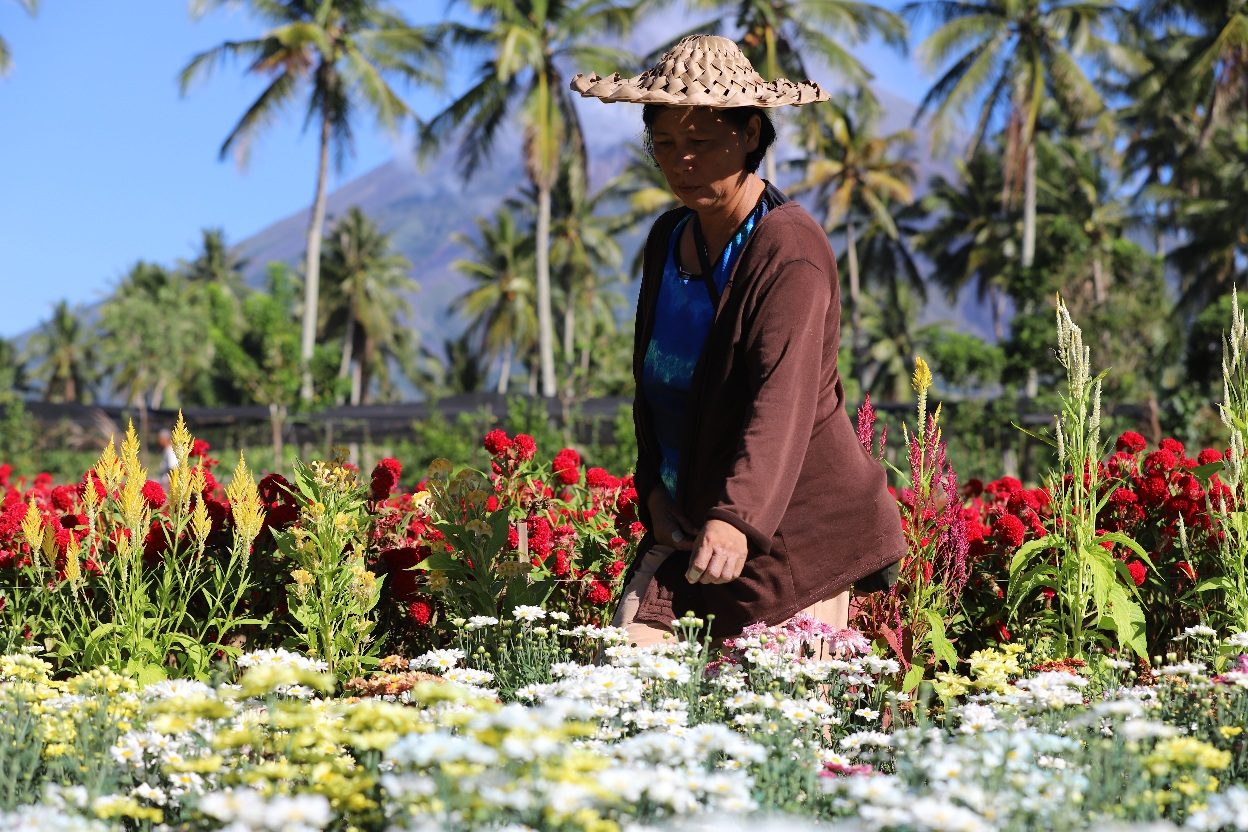SUMMARY
This is AI generated summarization, which may have errors. For context, always refer to the full article.

ALBAY, Philippines – In a village in Daraga town, a colorful flower plantation thrives in a rice field against the backdrop of Mayon Volcano.
Danilo Alaurin, 55, and his wife Eleanor, 52, work side by side on their small flower farm before daybreak and until sunset.
Just a few weeks ago, they received approval from the provincial government of Albay to return to their village just in time for All Saints’ and All Souls’ days when the demand for flowers was high.
The Alaurin family’s flower farm, located in Alcala village, Daraga, is in full bloom, despite being within a seven-kilometer radius of the permanent danger zone of Mayon Volcano.
The family planted various flowers in June, just days before the Philippine Institute of Volcanology and Seismology (Phivolcs) raised the alert level to 3 on June 8 due to increased volcanic activity.
Eleanor’s family, along with other families, had sought refuge in temporary shelters in Daraga, as mandated by the local government.
Ornamental farming in Albay, despite being small in scale, thrives in areas located near or at the foothills of the symmetrical Mayon Volcano, thanks to the fertile soil.

“My husband preferred to stay in our nipa hut so he could watch the ornamental plants while the volcano was restless. He kept a watchful eye on Mayon’s activity from a distance for over three months. Although he visited us in the evacuation camp, he returned here to tend to our ornamental plants,” said Eleanor, a mother of five children.
“We are delighted to be back on our farm because we can continue with our lives uninterrupted. My husband usually worked in the flower farm from dawn till dusk,” she added.
Aside from the flowers, the Alaurins also planted patches of vegetables such as string beans, taro, moringa, sweet potatoes, spring onions, and towering coconut trees.
Their flower farm is the largest among the flower plantations along the rice fields of Matnog and Alcala villages in Daraga.
The Alaurin couple began their flower farm in 1993, or 30 years ago, as an alternative source of income when their income from rice farming significantly declined due to low production.
“To generate extra income after rice farming, we decided to try planting flowering plants to see if it was profitable. Sure enough, we earned more, three times as much as from rice. So, from then on, we focused on ornamental plants and planted rice just once a year,” said Danilo.
Every day, Danilo and Eleanor spend their time on the flower farm while keeping a close watch on Mount Mayon’s lava flow and small pyroclastic materials generated by its eruptions.
“Ornamental plants are more profitable than rice because rice prices range from P17 to P20 per kilo, but with ornamental plants, we generate more than P50,000 per cropping season from this less than the half-hectare plot of land, locally called ‘bintingon.’ Our income is three times larger than from rice farming, even though ornamental plants require more fertilizer,” he said.
The Alaurin couple is a tenant of Nestor Granadino from Barangay Tagas, Daraga. Danilo has been tilling the farm since he was young – his parents were the original caretakers of the land owned by the Granadilo family.

Thanks to ornamental farming, the Alaurin couple was able to send four of their children to college, all of whom have graduated, while their youngest daughter, pursuing an education degree, is set to graduate this school year.
“We sell flowers annually during Undas, Valentine’s Day, and Holy Week when the demand for flowers is high,” Danilo said.
The Alaurin couple employs an integrated farming approach to generate income consistently alongside their ornamental farming.
“If you know how to manage it, there is a future and greater income in flower farming. Although it requires more time and effort than rice farming, it provides a rewarding income during the flowering stage,” he said. – Rappler.com
Add a comment
How does this make you feel?












There are no comments yet. Add your comment to start the conversation.